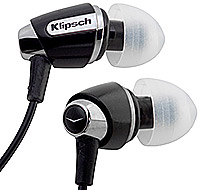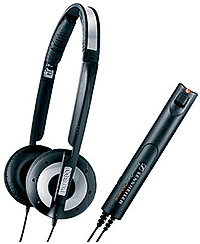Headphone Selection for Listening to Audiobooks
While it may at first seem that any old pair of headphones will provide good enough audio quality to listen to spoken word, there are three important things to consider when choosing equipment with which to do so.
The most obvious of these is comfort. You might be listening to an audiobook for extended periods of time, on a long flight or train journey for instance. As well as being annoying and painful, uncomfortable headphones (especially in-ear and earbud styles) could cause lasting damage to your ears.
Secondly, frequency response, while perhaps not quite as important for speech as for music, still has an impact. Our brains use the lower ‘bass’ frequency ranges to interpret speech, so we can deal with losing the high-frequency overtones quite well but not vice versa.
Finally, as many people listen to audiobooks on the go with a portable MP3 player, there is the issue of ambient noise. Whether on a train, plane, or just walking down the street, the general hubbub makes it harder to hear what is playing in our ears. It will generally occur with low, rumbling frequencies (engines, road noise) and also with mid-high and high ranges (music, talking). Turning up your volume to combat this noise can mean it reaching dangerous levels, which can cause temporary or permanent damage to your hearing.
With these three factors in mind, let’s look at the main styles of headphone available:

Earbuds are cheap to produce and are often bundled with personal audio players.
Earbuds
These sit in the pinna (or ‘outer ear’), covering the opening of the ear canal. Many MP3 players are supplied with these, and they can be made and bought very cheaply. Comfort can vary, depending on their size and the shape of your ear. Generally, though, they become uncomfortable after a short while.
Because they are small, their frequency response is good at high frequencies but falls when it comes to the bass. This generally gives them a ‘tinny’ sound. Furthermore, being small they provide poor isolation from background noise, requiring the listener to turn up the volume to potentially dangerous levels in order to hear their audio.

In-Ear Headphones share acoustical characteristics with earplugs, providing good isolation.
In-Ear Monitors
Similar in appearance to earbuds but slightly extended, these are designed to enter your ear canal much like earplugs. Also like earplugs, these headphones provide very good isolation indeed. Many high-quality in-ear headphones are now being made with a second ‘bass enhancing’ drive unit, improving overall frequency response.
As with the earbuds, the comfort can vary from headphone to headphone, and ear to ear. There is potential for serious damage in the ear canal that may affect your hearing, so when choosing in-ear phones the most important thing is to find some that fit snugly but are not too tight, and that don’t become uncomfortable in long listening sessions.
Probably the best choice for discretion and sound quality.

These supra-aural headphones attach to the outer ear by a clip, as opposed to a band going over or behind the head.
Supra-Aural Headphones
These sit on your ears, either with a band that goes over your head or behind your neck, or with clips that go behind your ears. These are useful for people who can’t use buds or in-ear headphones but still want something smaller and more lightweight than ‘full size’ headphones.
Listening for a long time can be uncomfortable with ear pads if you find that they are pressing down on your earlobes too much, or if a clip on your ear causes pain. Isolation is comparable with earbuds, depending on the size and how tightly they press on your ears. They do allow for larger drive units than in-ear styles, and this gives more power to the bass frequencies.

Circum-aural headphones, sometimes called ‘full size’ headphones, provide high quality but can be bulky.
Circum-Aural Headphones
The largest of the varieties, these surround your ears and have an image associated by most with professional audio. Isolation will vary and can be better than supra-aural headphones or earbuds, but won’t be as good as in-ear headphones. They are especially lacking in isolation against low, rumbling frequencies, and this is a big problem for speech.
Comfort depends more on your head than your ears themselves. They must rest over the top of your head, and all around your ears. Even though there is a certain amount of adjustment for tightness, some pairs will fit and some will not. You’ll also find that after long periods of listening, your ears will get quite warm as they are fully enclosed.

Using active noise control, these noise-cancelling supra-aural headphones can attenuate troublesome engine and road noise.
Noise-Cancelling Headphones
Using a process called ‘active noise control’, or ANC, these headphones increase perceived isolation by negating external noise rather than just soundproofing the ears. This is done using microphones on the outside of the cans, allowing sounds reaching the ears to be ‘subtracted’ from the audio content.
Normally the extra circuitry – including a power supply – will require these to be circum- or supra-aural headphones, and in these cases isolation is still second to in-ear styles. More recently, however, in-ear noise-cancelling headphones have become available, giving the benefits of ANC and the earplug design.
Noise-cancelling headphones will effectively reduce continuous, simple noise such as hum and rumbling. Transient and complex sounds, however, won’t be attenuated as much. Additionally, the ANC system can add hiss to the sound. There is also a need to recharge or replace the batteries that power the headphones.
Conclusion
In-ear headphones are best for isolation but can lack in bass frequencies. Full closed-back or pad headphones will give you a fuller spectrum, but even if they are noise-cancelling they cannot provide the same isolation. Earbuds are cheapest, while noise-cancelling headphones, especially in-ear ones, will cost you the most. In terms of comfort it is impossible to objectively judge, since it is largely down to personal preference and the shape of your own ears. The important thing is to try out a few before you buy, if possible, to find what fits best and to hear for yourself the differences in quality and isolation.
Mike Shah